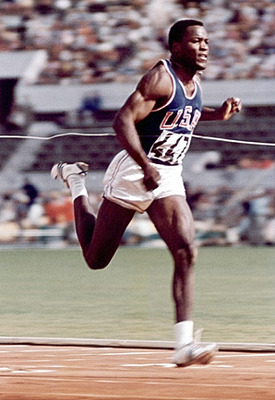When Rafer Johnson Broke the Decathlon World Record—After Only 9 Events
Many who witnessed Ashton Eaton’s incredibly moving decathlon world record at the 2012 Olympic Track and Field Trials in Eugene, Oregon swear they will never see another sporting performance so inspiring.
I would never attempt to minimize such sentiments, as it truly was one of the signature moments in all of track and field.
Yet 52 years earlier, decathlete Rafer Johnson drew upon the same Hayward Field magic to lay down an earlier version of one of the sport’s most grueling accomplishments.
Let’s take a look back at another episode in the amazing legacy of Hayward Field.
The U.S./USSR Cold War rivalry of the mid-20th century was typified by the decathlon’s back-and-forth world-record duel between the American, Rafer Johnson, and then-current record-holder (8,357 points) Vasili Kuznetsov of the Soviet Union.
The record, in fact, had alternated between the two athletes four times since 1955.
And so it was, at the 1960 Amateur Athletic Union’s decathlon championships in Eugene, Johnson’s patriotic intent was as much to break Kuznetsov’s record as it was to secure a berth on the 1960 Rome Olympics team.
In an uncanny subplot, Johnson’s UCLA teammate and good friend, C.K. Yang of Formosa (Taiwan), stood as a potential roadblock to the American’s quest. He was, after all, the defending collegiate national champion and a legitimate contender for the record in his own right.
Rafer was a powerfully built hybrid of speed and strength, evidenced by his expertise in the sprints and throwing events. The three-time AAU champion was the silver medalist at the 1956 Melbourne Games but was on the comeback trail after an automobile accident had derailed his entire 1959 season.
Yang was a chiseled, wiry athlete who excelled in the hurdles, jumps and mid-distance races. As a foreign citizen, he was not eligible for a spot on the U.S. Olympic team, but was competing as a UCLA representative and of course, was himself cognizant of Kuznetsov’s record.
(As a testament to Yang’s credibility as a world-class decathlete, he would eventually become an elite vaulter in the open pole vault—16 feet, 3.5 inches—and become the first to eclipse 9,000 points —9,121—under the old scoring system, which was in use in that era.)
The AAU meet in Eugene progressed according to most form charts. Johnson won the 100 meters, shot put and discus and scored heavily in the long jump, high jump, 400, high hurdles and pole vault.
On the second day, after eight events, Rafer was on world-record pace. Remarkably, Yang was still within striking distance as well, with only the javelin (a Johnson strength) and the 1,500 meters (a Yang strength) remaining as obstacles.
I’ll let James Murray, who wrote up the dramatic moment for Sports Illustrated, describe Johnson’s next effort:
A hoarse roar rocked the aged structure of the University of Oregon’s Hayward Field. As the javelin stabbed quiveringly into the grass, an announcer’s voice sputtered hysterically from the public address system: “Ladies and gentlemen,” he shouted, “if that javelin has, as it appears, gone over 230 feet, Rafer Johnson has just broken the world decathlon record of the Russian Vasili Kuznetsov!”
A further roar shook the creaky wooden stands. Down on the field, Rafer Johnson first sped excitedly after his victorious javelin, then abruptly knelt in midfield and said a prayer. When he returned to the officials’ mark, his normally stoic face was twisted in an unsuccessful fight against tears.
The javelin flew 233’3″ to be exact, and before the final event began, Johnson had clinched his primary objective, eclipsing the Russian’s record—by 124 points. He could have walked off the field at that point, with only an excruciating 1,500 remaining. But he did not.
No, there remained another aspect of the athlete’s persona for the sporting world to discover.
About a lap into the 1,500, Yang began to struggle with leg cramps. Johnson, seeing his friend and teammate on the verge of collapse, maneuvered to his side, nudging him along at a less-than-optimum pace.
They finished together in a pedestrian five minutes, nine seconds, but it was quick enough to give Yang himself an almost-obscured 69-point cushion over Kuznetsov’s old record.
Johnson, who clearly could have put his record out of reach for at least a decade, instead accepted a meager 202 points for his benevolent act, bringing his record total to 8,683.
Both he and Yang met again in Rome that year in one of the classic Olympic duels of all time. It would be Rafer Johnson’s last competition, but thankfully it was not before he left a bit of history on the track, turf and timbers of Hayward Field.
Rojofacts: It was for this particular AAU meet that Bill Bowerman moved and reconfigured the long jump runway and pit to its present prominent location before the west grandstand.
The innovative rubber/asphalt runway produced several personal records during the long jump decathlon discipline, including Johnson’s 24’9″ and an incredible 26’3″ leap by Mike Herman.
Since the days of Rafer Johnson and C.K. Yang, the decathlon scoring tables have been revised several times. Using the current tables, Johnson’s 1960 record (8,683) would be converted to 7,981, making Eaton’s world record (9,039) seem even more impressive.
Johnson and several other decathlon greats were present at Hayward Field earlier this year to witness Eaton’s dramatic feat.
(Rojo Grande also writes under the pen name of Red Shannon)


I think the admin of this website is really working
hard in support of his web site, for the reason that here every data is quality based material.